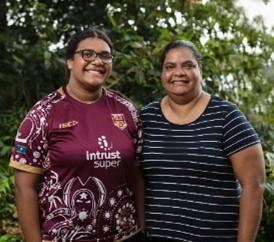Liana’s story begins nine years ago. It starts with a sore ankle, a fever, a trip to the emergency room and clinic and finally a diagnosis of acute rheumatic fever (ARF); a disease that continues to show up in Aboriginal and Torres Strait Islander people. When asked about what she remembers about that time in her life she recalls the big things, the memories that stick after such a life changing event.

Liana and Margaret O'Brien
“I remember it was my birthday. I remember being told I’d have to have needles and I remember being scared. I didn’t know what ARF was so I didn’t understand why I needed to have all these tests and needles,” Liana says.
Her mum, Margie, recalls in more detail, the emergency department visit and the follow up appointment at the clinic. She was confused how one minute her daughter’s ankle was so sore, numb, and swollen she couldn’t walk on it, and then a couple of days later she as walking on it again.
“It was a couple of days before Christmas. Liana had a sore foot and was complaining about it. I thought she had just hurt it running around playing with her brothers and sisters. Over the next few days it got progressively worse and by Boxing Day she was bed ridden and unable to walk. By that point, I thought she had maybe broken her ankle. She also had a slight fever, but it wasn’t too high. I didn’t think her fever had anything to do with her sore ankle”
“We went to the emergency department and they did an x-ray, which came back normal, so they just gave her some ibuprofen and told me to follow with a GP if it didn’t settle down. Next thing I know she’s up running around and it’s all good again. I thought that was really strange, so I booked her in to the clinic to see the GP,” Margie recalls.
Acute rheumatic fever (ARF) can be difficult to diagnose, especially for clinicians who may not be familiar with the varying signs and symptoms, some of which come and go over a period of weeks and can appear unrelated to each other, such a fever and sore joint.
“The GP was very suspicious, so she rang the paediatric doctor at the hospital, who advised Liana have some blood tests done. The results showed she probably had rheumatic fever,” Margie says.
A timely diagnosis of ARF is critical to preventing rheumatic heart disease. If ARF isn’t diagnosed straight away the chance for repeated infections of Strep A increases. This can lead to recurrent cases of ARF, which then leads to an increased chance of developing rheumatic heart disease (RHD). Luckily for Liana, her mother followed up with a GP who then referred her to a cardiologist who confirmed there was no sign of heart damage.
Currently, there is no diagnostic laboratory test for ARF, so diagnosis remains a clinical decision based on specific symptoms and signs associated with ARF, which as Liana’s story has shown, can be fraught with difficulties.
A test for ARF, and targeted treatments that reduce development of its complication, RHD, would be highly valuable for Australian Indigenous people, New Zealand Māori and Pacific People and other affected populations around the globe.
Understanding the immune processes causing ARF are complex and the technology to find a unique ‘diagnostic signature’ has not been previously available. The START study aims to use new methods to test immune responses in blood samples from people with and without ARF to find a unique signature that reliably identifies ARF. This will lead to the development of a point of case diagnostic test for ARF. This test will allow early detection of the disease and early intervention, with the ultimate goal of eliminating the progression to RHD.

